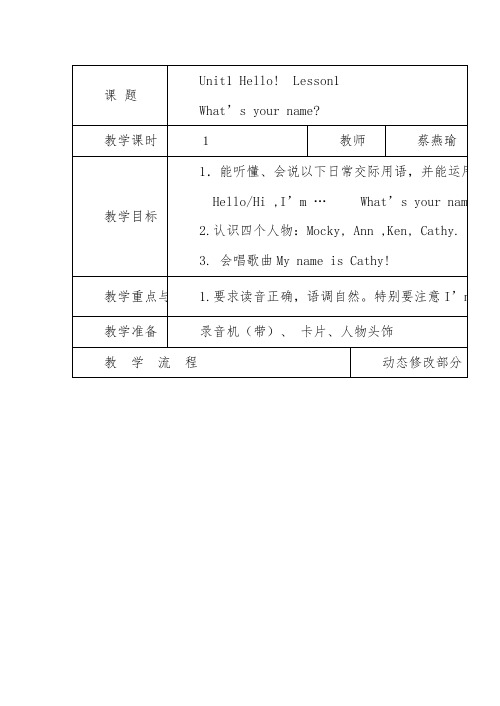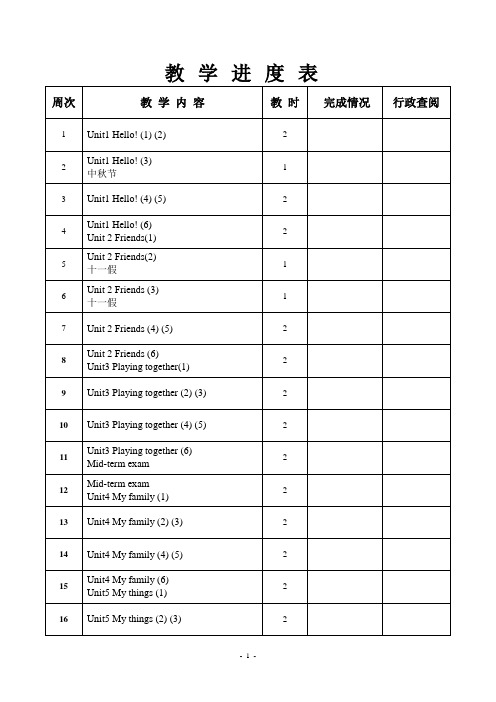北师大小学英语教案UnitDayandNight
- 格式:doc
- 大小:122.00 KB
- 文档页数:40

北师大版(三起)英语五年级上册全册教案(总37页)--本页仅作为文档封面,使用时请直接删除即可----内页可以根据需求调整合适字体及大小--北师大版小学英语五年级上学期(第7册)教学计划和教案Unit 1 Mocky the juggler一、教学目的与要求目的通过情景对话,初步掌握如何询问工作;掌握单词: farmer, policeman, vet, doctor, pilot, dancer, student, call, help, juggle, teach.复习字母Aa, Ii, Ee, Oo的发音要求听.说( 1 ) 能在情景对话中,能正确使用本课所学的询问工作的句型及回答。
( 2 ) 能熟练地听.说出; farmer, policeman, vet, doctor, pilot, dancer, student, call, help, juggle, teach.( 3 ) 能听懂本课中的单词的意思,正确区分字母Aa, Ii, Ee, Oo的发音( 4 ) 能准确、流利的读出本课故事及对话.读能用正确的语音语调读出本课出现的日常用语;;能熟练.准确.流利的朗读故事.能朗读本单元后的阅读练习,并完成相应的阅读练习.写能正确.熟练,整齐的在三格本上写出单词,并会默写出本课出现的单词;能够正确、规范的抄写句型及正确的翻译句型。
二、教学内容与重点教学内容日常交际用语 Is she a doctor?No, she isn’t.What does she do?She is a vet.Are you a vet?Yes, I am.2、单词本课日常交际用语及字母教学中的单词:farmer, policeman, vet, doctor, pilot, dancer, student, call, help, juggle, teach, snake, three, Sue, bike, nose, beans, gate, kite, bone, flute.教学重点以上交际用语在具体情景中的应用;单词farmer, policeman, vet, doctor, pilot, dancer, student, call, help, juggle, teach.第一课时教学内容:1.交际用语 What does she do? She is a vet.2. 单词::farmer, policeman, vet, doctor, pilot, dancer, student, call, help,juggle, teach,教学目的:1、通过本课的学习,学生能够正确流利地读出课文中的交际用语并能运用这些句型进行交际。




Unit 9 Day and night 教学设计教学目标1、学生能够掌握字母or和oor在单词中的发音,并能完成练习;2、能熟练掌握小黑板关于使用频率词汇的句型,并能运用always、usually、often、sometimes、never回答有关于日常生活规律的问题;3、能运用频率词汇说一说自己的日常生活。
学情分析本节课的教学对象是我校四年级的学生,学生整体情况如下:1、大多数学生对英语学习有浓厚的兴趣,喜欢听英语、说英语,乐于用英语交流,思维活跃,善于模仿;2、学生经过将近四年的英语学习,已经能够感知单词的发音规律并能在一定的引导下总结发音规律;3、经过前三个课时的学习,学生已经能够初步掌握表示频率的词汇的用法,并能尝试初步运用;4、仍有少数学生对用英语进行表达感觉吃力,有畏难情绪;or和oor的发音对于学困生来说不易掌握。
重点难点1、学生能够掌握字母or和oor在单词中的发音;2、能运用always、usually、often、sometimes、neve说一说自己的日常生活。
教学过程【导入】Warm-upSing a song~BINGOIntroduce Little Jack.T:Just now we sang a song about a farmer.Look,this is Little Jack.He is a farmer,too.Let’s say Hello to him.【讲授】Presentation1.Visit Little Jack’s house结合图片首次感知语音词汇;T:Oh,this is Jack’s house. There are many things on the floor.What are they?2.Help Little JackT:It’s not clean.Let’s clean them up.Where can we put them?3.Chant1)Listen to the ChantT:Oh,now his room is very clean so he is very happy.Listen!He is chanting for you.2)Look and say(Show the chant.)3)Practice in groups4)Show the chant5)Chant with Little JackT:Who wants to chant with Little Jack?You can stand up.4.Present the words(以文字的形式呈现语音词汇)【练习】Practice OneI.Learning1、Try to readT:Good!You did very well.Can you read these words?2、Listen and readT:Now let’s read follow the computer and pay attention to these red letters.3、Try to find the rulesT:Great!What do you find?(引导学生说出字母o和or/oor的发音规律)II. Rules4、Say out the wordsT:Can you try to read these words?板书:o or/oorg o t l or dd o t m or e... ...5、Say more words like theseT:Can you say any words like these?III. Practicing6、Task One~Cross the riverT:Good!Oh,you know so many words now.Can you help Jack?He wants to cross the river.But some parts of the woods are broken.Can you find and cross them?Now do it in groups.7、Task Two~Pick up some mushroomsT:Now Jack can cross the river.Can you guess what will he do?T:Oh,he wants to pick some mushrooms.And look there are many mushrooms and there are two baskets.Can you put them into the right basket?Do it in groups.T:Which group wants to show your baskets?【练习】Practice TwoI. Let's learn1.Play a Game~Words poolT:Little Jack is very happy.It’s dinner time.He wants to wash the mushrooms in the water.Look!Here’s the pool.Oh,it’s a words you want to play a game?T:I will point some words and these words can make a sentence.When I stop,you should say out the sentence as quickly as you can.(教师指出句子)2.Read Uncle Booky’s BlackboardT:Oh,there are many sentences in this pool but wait a minute let’s read them first.3.Read Uncle Booky’s Blackboard.4.Play the Game.(学生指句子)T:Now,it’s your turn.Who wants to point a sentence for us?II. Let's say1.GuessingT:Oh,Little Jack not only picks the mushrooms every day.He also has many things to do.Can yo u guess what things he does every day?2.Ask and answera.T:Let’s see what things he does every day.(呈现图片)b.T:Do you want to know when he does these things?Let’s ask him.板书:When do you...?Let’s listen.板书:I always...3.Order the words.【活动】Extension1.Touch and SayT:Now we know when Little Jack does these things.Do you remember our friend Ken?(出示PPT)a.Guessing what are they talking aboutT:Oh,he is talking with his friend.What are they talking?S:They are talking about the time.T:Yes,let’s read it together.b.Ask and answer in pairsT:Please open your books.Turn to Page33.Look at these pictures.And try to ask and answer in i s Ken and another one is his friend.T:When does Ken...?板书:When does...?He usually...c.Show the dialogue.2.Read about Ken’s daily lifeT:Oh!This is Ken’s daily life.Read it in your groups.3.Say something about your life.T:Listen!What did he say?(播放Ken的录音)T:Can you talk with your partner?And you can use these phrases or what other things you want to say.【作业】Homework1)Practice the pronunciation;2)Try to write about your daily life。

Unit 9 Day and night教学设计1一、教学目标:知识能力:1、复习巩固前两单元的教学内容。
2、学习频率副词usually, sometimes, never, always , often.并初步运用。
3、初步感知课文故事,体会功能句型和频率副词的运用环境。
过程方法:采用视听,师生互动,小组合作,调查访问等方法,引导学生在感知,体验,参与和合作中学习并运用英语。
情感态度:1、培养学生主动参与,大胆实践,敢于开口说英语的良好学习习惯。
2、培养学生的合作精神。
二、教学重点、难点:重点:能听懂、会说、会用功能句型。
When do you get up ?I usually get up at 6:00 .或What do you usually do on Sunday?及回答。
理解并初步掌握新单词。
Always , usually, often, sometimes, never.难点:初步掌握频率副词并能在功能句中运用。
三、教具准备:教学课件一套,调查表一份,单词教学卡片数张。
四、实践活动:小组活动,调查访问。
五、板书设计:Unit 9 Day and nightWhen do you get up?always 6:00usually 6:30I sometimes get up at 9:00never 11:00She often gets up early.六、教学过程:(一)、谈话唱歌,激发兴趣。
1、谈话复习第一单元的内容。
T:What day is it today?S:It’s Friday.T:Saturday is coming. Are you happy? Let’s sing an English song.2、展台出示歌曲,师生跟唱歌曲,复习第二单元的内容。
What time is it?(二)感知句型,学习单词。
1、(出示钟表图片)在句型中引入新单词。
T:What’s this?S: It’s a clock.T: What time is it now?S: It’s 6:00.T: It’s time for get up.I get up at 6:30 in the morning.When do you get up?S: I get up at 6:00.2 、在实物展台上,出示调查表,初步理解频率副词。
Unit 9 Day and night一、教学目的:1.通过学习,能够用英语简单描述自己一天的活动。
2.对学生进行养成安排良好作息时间的教育。
3.培养学生的综合素质及英语能力。
二、教学重点:1.掌握下列这些句型:When do you always/usually/often/sometimes/never/ eat breakfast?I __________ eat breakfast__________.2.When does he always/usually/often/sometimes/ do in the morning?He_______ goes to the store___________.教学难点: 能在相关的语境中正确运用所学句型。
三、教学方法: 听、读、说、演等。
四、教具准备: 教学卡片、多煤体等。
五、教学过程:1、导入师:What time do you go to school ?生:I go to school_____________.2、学习生词always、usually、often、sometimes、never。
1). 学习生词always师:What time do you get up ?生:I get up at ______________.师:Yes, I always get up at six .师再问:When do you get up ? (When means what time)师出示when生词卡片,学习生词when。
师再问另外几个同学此句型,师还用I always ______________.句型回答。
师出示always生词卡片,学习生词always。
2). 用同样方法的学习usually、often。
3). 学习生词sometimes 师: When do you go to bed every day ?生: I go to bed at __________.师: Oh , you go to bed too late. So you sometimes go to school late .师出示sometimes生词卡片,学习生词sometimes.4). 学习生词never.师: When do you go to bed every day ?生: I go to bed at __________.师: Oh , you go to bed too early. So you never go to school late .师出示never生词卡片,学习生词never.5). 跟录音认读生词always、usually、often、sometimes、never。
教师学科教案[ 20 – 20 学年度第__学期]任教学科:_____________任教年级:_____________任教老师:_____________xx市实验学校北京师范大学出版社小学英语四年级教案全册备课对新课标理解:现在的社会是向着全球化,社会化发展的英语逐渐的成为我们生活中不可缺少的一部分,越来越被人重视,作为教育发展的重要环节,作为迎接未来世界的一把钥匙。
新课标强调课程应从学生的学习兴趣、生活体验和认知水平出,倡导学生体验、实践、参与、合作与交流的学习方式和任务型的必学途径,发展学生的综合语言运用能力,使语言学习的过程成为学生形成积极的情感态度,主动思维和大胆实践,提高跨文化意识和形成自主学习能力的过程。
做到这些要求,首先需要的就是学生浓厚的对英语学习的兴趣,那怎么样培养学生学习兴趣就成了一个基础话题,这一问题要面向全体学生,特别是要关注学生的个别差异引起的情感问题。
帮助学生建立成就感和自信心。
在教学中注意创设能引导学生主动参与的教学环境,激发学生的学习积极性。
使每个学生都能得到充分的发展。
在这一过程中教学模式的转变起到了一定的作用,一定要从以老师为中心的教学模式身以学生为中心的教学模式转变。
强调学生的参与和体验,强调采用多种形式的教学活动。
比如可以利用我们学校已有的良好电教资源,听原版录音带练习发音,也可以利用网络找一些贴近课堂学习的情境对话或小动画,以更直接的方式引导学生学习英语,对英语产生浓厚的兴趣。
总的来说,新课标对发展学生自我主观能动性起到了很积极的作用。
素质教育在其中深有体现。
并且由升学教育向终身教育的转变等等都是很好的突破。
在这一新课标的指导下,希望在英语教学中可以达到更好的效果。
Teaching Aims:知识技能:1、Listening:充分利用学校的电教资源,在发展学生自主学习的基调上,让学生可以接触到更多、更直观的学习方式,比如听录音,看小动画等等。
掌握部分日常用语,如:能听懂询问名子的问及回答,或问是谁的语句。